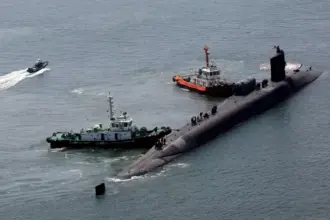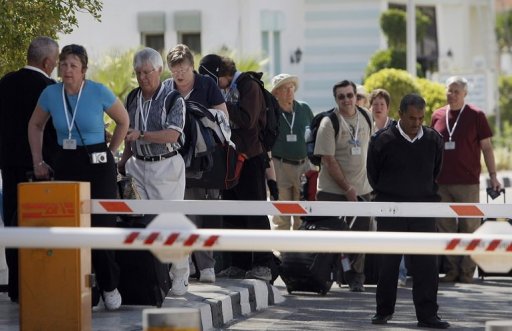On Wednesday, US President Donald Trump declared he is pulling his country out of the nuclear deal with Iran in a move that was anticipated for several weeks.
Under the deal brokered in July 2015, Iran agreed to limit its nuclear activities and allow observers to monitor its commitment—which it largely did—in exchange for lifting sanctions. The parties of the agreement included the US, the UK, Russia, France, Germany, China, and the European Union.
One leader was not celebrating the breakthrough. Israel Prime Minister Benjamin Netanyahu called the agreement, known as the Joint Comprehensive Plan of Action (JCPOA), a “historic mistake.”

Trump called it a “horrible, one-sided deal.” The UK, Germany, and France rejected the US withdrawal and said they would remain committed. For his part, Iran’s supreme leader, Ayatollah Ali Khamenei, requested guarantees from the European countries that trade relations be preserved, or else threatened to end his country’s commitment and restart its enrichment programme.
For an Arab alliance led by Saudi Arabia, the US position comes amid escalation against Iran on grounds of the Islamic republic’s growing regional interference. Saudi Arabia, which is also leading an alliance of Arab forces fighting the Iranian-backed Houthis in Yemen, has repeatedly accused Iran of being behind ballistic missile attacks on the kingdom.
In June 2017, Saudi Arabia, the UAE, Bahrain, and Egypt announced their boycotting of Qatar, citing terrorism funding and ties with Iran. The Arab League adopted a similar rhetoric that Iran is meddling with regional affairs and destabilising Arab countries, eventually aligning with Trump’s vision that the nuclear deal should be revised as it did not address other problems caused by Iran.
Iran’s presence in Syria has been a particular headache for the Saudis, which disliked the US desire to withdraw from Syria.
Once an ally of Saudi Arabia and a good friend of Israel, Iran has become the mutual threat bringing together the US-Israel force with the Saudi-led coalition. Iran’s relations in the Middle East have been shifting in line with regional changes, with its growing influence manifested through supporters in different countries.
Iranian influence in the Middle East
In 2014, Iranian MP Ali Reza Zakani, who is reportedly close to Supreme Leader Khamenei, made a statement in which he bragged that three Arab capitals were in the hands of Iran and belonged to the Islamic Iranian revolution, noting that the fourth was on its way to joining.
He was referring to Beirut, Damascus, and Baghdad, noting, “the revolution of the Houthis in Yemen is an extension of the Khomeini revolution,” referring to the 1979 revolution led by Khamenei’s predecessor and founder of the Islamic Republic of Iran, Ayatollah Ruhollah Khomeini, according to media reports.
Lebanon’s Hezbollah is Iran’s strongest foothold in the region. Founded in 1982 by a group of Shiite clerics, it was inspired by Khomeini, who led the Iranian revolution that overthrew the Iranian monarchy. The party’s quest has been to fight Israel and end its invasion of Lebanon.
Hezbollah has been a strategic arm of Iran and has been involved in the Syrian civil war through the National Defence Forces fighting against rebels and assisted by Iran.
In November, Prime Minister Saad Al-Hariri announced a controversial resignation, citing objections to Iran and Hezbollah policies in Lebanon and the region. The surprise move is believed to have been forced upon him by Saudi Arabia, which he was visiting the capital of. Al-Hariri revoked his resignation once he returned to Lebanon.
In Iraq, Iran played a significant role in fighting against the Islamic State group through the Popular Mobilisation Forces, also providing assistance to the Kurdish Peshmerga. Iran has been backing the regime of Bashar Al-Assad and the Houthi rebels in Yemen.
Iran’s allies Russia, Turkey, and Qatar are also in conflict with the US, as well as European and Arab countries. As it stands, Saudi Arabia and Israel continue to lobby against Iran and gather their allies. Last week, Morocco cut diplomatic ties with Iran, accusing it of assisting the Polisario Front, a group seeking to establish the independence of Western Sahara, a region claimed and partially occupied by Morocco.
In an op-ed published on Saturday, the editor-in-chief of the privately-owned Al-Shorouk newspaper, Emad El-Din Hussein, said Arabs ought to sit and negotiate with Iran just as they did with the Israelis. According to him, Iran could take the initiative to cease support for the Houthis and stop interfering in Iraq and Lebanon, while leaders of Saudi Arabia and the UAE should announce they are willing to visit Iran and lend it Arab support.
On the other hand, Israel has been escalating tensions against Iran, mainly by attacking their targets in Syria, to which Iran’s response has been limited. Just ahead of Trump’s decision, Israeli PM Netanyahu said he had proof that Iran was lying about its nuclear programme. The US has warned Iran against any harm to Israel.
Amid a chaotic scene that is continuously and rapidly changing, Europe is trying to maintain the nuclear deal with Iran as the rest of Arab countries hold their breath in fear of another outbreak of violence that has shaken the region in the aftermath of the 2011 Arab Spring.
Egypt-Iran relations
Marked by ideological and political differences, relations between Egypt and Iran vacillated between hostility and approval for decades, depending on who ruled each country and which regional interests were prioritised during the time period.
Egypt has long accused Iran of supporting its largest opposition group, the Muslim Brotherhood. During the 18-day revolution which toppled Mubarak, more public blame was directed at the Iran-backed groups Hamas and Hezbollah over supporting the Muslim Brotherhood and plotting to release Islamists, including the eventual president Mohamed Morsi.
Mubarak considered Iranian influence through Hezbollah and Hamas a growing threat, especially the latter, which took control of the Gaza Strip in 2007, across the Egyptian border.
Egypt-Iran relations timeline
1939 – Princess Fawzia, daughter of Egyptian King Fouad, married Mohammad Reza Pahlavi, who would later become the last shah of Iran
1952-1953 – Gamal Abdel Nasser led a revolution creating Egypt’s republican system, promoted Arab nationalism, and allied with the Soviet Union. Pahlavi’s monarchy was restored in Iran, backed by the UK and US
1960 – Diplomatic relations between Cairo and Tehran ruptured, amid a political and ideological conflict. Iran perceived pan-Arabism as a threat. The shah enjoyed good relations with Israel, with whom Egypt was at war
1962 – Yemen’s civil war: Egypt sent military forces to Yemen to support revolutionary republicans, supported by the Soviets. On the royalist side stood Saudi Arabia, Iran, Israel, and the UK
1970 – Egypt and Iran restored diplomatic relations, one month before Nasser’s death in September
1971 – Egypt’s then-president Anwar Al-Sadat met with the shah of Iran. Distance further shrunk due to a mutual desire to cooperate with the Soviet Union
1973 – Iran provided different types of aid to Egypt during its war against Israel
1979 – An Islamic revolution in Iran toppled the shah, and the new Iranian leadership declared hostility towards the West
Al-Sadat signed a peace treaty with Israel and granted the overthrown shah asylum in Egypt
1980-1988 – Egypt supported Saddam Hussein’s Iraq in its war against Iran, intensifying Egypt-Iran conflicts
1981 – Al-Sadat was assassinated and Iran named a street after the perpetrator, Islamist militant Khaled Al-Islamboli, which Egypt would maintain as a main obstacle to restoring good relations
2008 – Former Egyptian president Hosni Mubarak met in Cairo with Iranian Parliament Speaker Gholam-Ali Haddad-Adel. A year earlier, Ali Larjani, at the time secretary of Iran’s Supreme National Security Council, visited Cairo
2011 – Iran appointed an ambassador to Egypt for the first time in 30 years, nearly two months after Hosni Mubarak was toppled during the 25 January 2011 revolution
2012 – Former Egyptian president Mohamed Morsi visited Iran to attend a summit of the Non-Aligned Movement
2013 – Mahmoud Ahmadinejad became the first Iranian president to visit Egypt since 1979 for a summit of the Organisation of Islamic Cooperation



